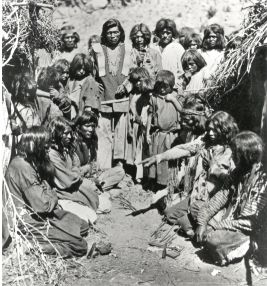The first inhabitants of Zion were nomadic hunters known as the Anasazi (Navajo for "Ancient Ones"). The magnificent ruins of their dwellings, which were built around A.D. 750, are found throughout the Four Corners area where the states of Colorado, New Mexico, Arizona, and Utah meet. The remains of one large Anasazi settlement were discovered in the Parunuweap Canyon at Zion.
While the Anasazi were farming the southern part of what is now Zion National Park, the northern part was occupied by people belonging to the Fremont Indian culture. But by A.D. 1200, both the Anasazi and the Fremont had begun to decline. Archeological findings suggest that as a sophisticated architecture developed, an increasing number of trees were used for building and fuel, thus destroying the water sheds so vital for crops, game, and forage food. According to this "ecological suicide" theory, the lack of raw materials and food eventually forced a mass exodus, perhaps as many as 700 years ago.
The Paiutes
During the next several hundred years, the region was visited by small bands of Fremont descendants, but Zion was not permanently populated again until the nineteenth century. We know the settlers as Paiutes, a tribe of Native American closely associated with some of Zion's great legends the pranks of Kai-ne-sava, the God of Fire, who set great flames (lightning) atop the West Temple, and the doings of Wai-no-pits, the Evil One, who invaded the Indian camps with disease. So deeply ingrained were these superstitions and the fears that grew out of them that the Paiutes were of little value as guides to the early white explorers.
Isaac Behunin, a Mormon pioneer and farmer, is credited with naming ZION, (Place of Peace) from a reference to a heavenly city in the Bible. But when Mormon leader Brigham Young paid a visit to the area in 1870, he was not impressed enough to allow such an earthly place to have such a heavenly name. So, in 1909, when President William Taft declared the canyon a National Monument, the Paiute name MUKUNTUWEAP (sacred cliffs) was chosen. However, locals continued to refer to the area as Zion, and in 1917 the name was changed to ZION CANYON. The name ZION NATIONAL MONUMENT was given in 1918.
TEMPLE OF SINAWAVA: "Sinawava" refers to the Coyote God of the Paiute Indians.
Many Zion place names come from Paiute theology including MOUNT WYNOPITS (after Wynopits, the God of Evil) and MOUNT KINESAVA (after Kinesava, the Trickster).


3 comments:
Writerfella here --
The text presented in the central post is the usual, extremely pre-digested and brief 'historical overview' of Native history for the tourist crowd, whose attention spans are not that demanding in the first place. It indeed is likely that the Anasazi once were located in what now is Zion National Monument. But the Zion area has been vacant far longer than the digested 'history' suggests. Again, the Anasazi indeed may have used up natural resources in the Zion area but all that means is that they moved further south, rather than all of "The Abandonment" happening at one and the same moment, which again is what the digested 'history' represents. This all comes from writerfella's own research into existing plus instantly appearing materials by which ANASAZI The Screenplay was guided and thence has been kept current over time. The huge Anasazi cliff carving discovered in 1987 by Robert E. (renamed "Brokeback Canyon" for ANASAZI The Screenplay by writerfella) reveals by its now-secret location that the Anasazi had moved even further south from the Chaco area, proving that "The Abandonment" simply was a slow and normal migration that nowhere was near being either instantaneous or even simultaneous. Now this is where writerfella's revelations stop, as he and his friends (such as Robert E., a Chippewa poet) have made further observations and discoveries that would astound the attendees of the Chacmool and Sipapu Conferences. But that's the breaks of the game, since we prefer that our people's history remain whole and complete, not winding up becoming pre-digested pap for white tourists who believe that their own history is sacred and blessed...
All Best
Russ Bates
'writerfella'
"Brokeback Canyon"...cute.
I hope your screenplay gets produced eventually, or your so-called secrets will die with you.
Writerfella here --
It matters not if ANASAZI The Screenplay is produced or not produced in writerfella's own lifetime. He has made a will in which his youngest sister Arlene becomes the inheritor of all rights and assignments, plus income, to writerfella's inventories as a writer for print and film. She is canny enough to administer such intellectual properties appropriately and so writerfella very much feels that, should he succumb to his autoimmune conditions, his legacy is safe.
All Best
Russ Bates
'writerfella'
Post a Comment